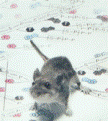Papers in the Biological Sciences

Jay F. Storz Publications
Document Type
Article
Date of this Version
2009
Abstract
Patterns of amino-acid polymorphism in human mitochondrial genes have been interpreted as evidence for divergent selection among populations that inhabit climatically distinct environments. If similar patterns are mirrored in other broadly distributed mammalian species, then adaptive modifications of mitochondrial protein function may be detected in comparisons among locally adapted populations of a single wide-ranging species, or among closely related species that have adapted to different environments. Here, we test for evidence of positive selection on cytochrome b variation within and among species of the ecologically diverse rodent genus Peromyscus. We used likelihood-based comparisons of synonymous and nonsynonymous substitution rates to test for evidence of divergent selection between high- and low-altitude haplogroups of the deer mouse, Peromyscus maniculatus. We also tested for evidence of divergent selection among different species of Peromyscus that inhabit different thermal environments. In contrast to the purported evidence for positive selection on mitochondrial proteins in humans and other nonhuman mammals, results of our tests suggest that the evolution of cytochrome b in Peromyscus is chiefly governed by purifying selection.


Comments
Published in Heredity 102 (2009), pp. 226–235; doi: 10.1038/hdy.2008.124 Copyright © 2009 Macmillan Publishers. Used by permission. http://www.nature.com/hdy